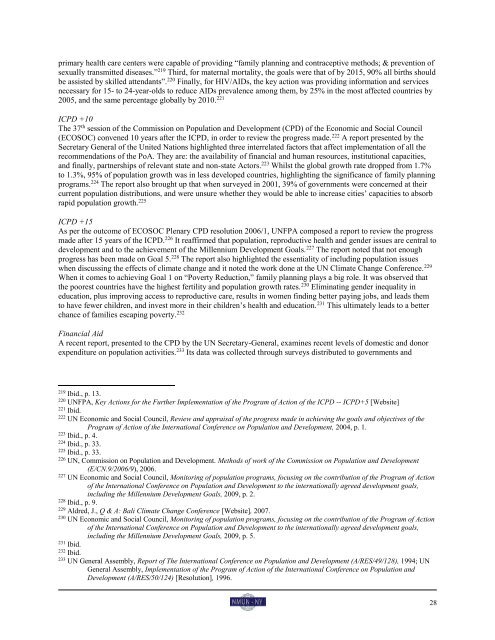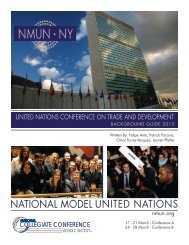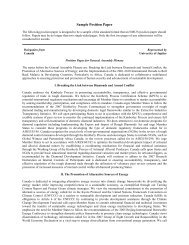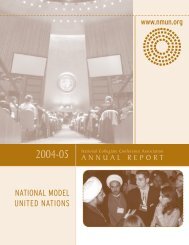UNFPA Background Guide - National Model United Nations
UNFPA Background Guide - National Model United Nations
UNFPA Background Guide - National Model United Nations
You also want an ePaper? Increase the reach of your titles
YUMPU automatically turns print PDFs into web optimized ePapers that Google loves.
primary health care centers were capable of providing “family planning and contraceptive methods; & prevention of<br />
sexually transmitted diseases.” 219 Third, for maternal mortality, the goals were that of by 2015, 90% all births should<br />
be assisted by skilled attendants”. 220 Finally, for HIV/AIDs, the key action was providing information and services<br />
necessary for 15- to 24-year-olds to reduce AIDs prevalence among them, by 25% in the most affected countries by<br />
2005, and the same percentage globally by 2010. 221<br />
ICPD +10<br />
The 37 th session of the Commission on Population and Development (CPD) of the Economic and Social Council<br />
(ECOSOC) convened 10 years after the ICPD, in order to review the progress made. 222 A report presented by the<br />
Secretary General of the <strong>United</strong> <strong>Nations</strong> highlighted three interrelated factors that affect implementation of all the<br />
recommendations of the PoA. They are: the availability of financial and human resources, institutional capacities,<br />
and finally, partnerships of relevant state and non-state Actors. 223 Whilst the global growth rate dropped from 1.7%<br />
to 1.3%, 95% of population growth was in less developed countries, highlighting the significance of family planning<br />
programs. 224 The report also brought up that when surveyed in 2001, 39% of governments were concerned at their<br />
current population distributions, and were unsure whether they would be able to increase cities’ capacities to absorb<br />
rapid population growth. 225<br />
ICPD +15<br />
As per the outcome of ECOSOC Plenary CPD resolution 2006/1, <strong>UNFPA</strong> composed a report to review the progress<br />
made after 15 years of the ICPD. 226 It reaffirmed that population, reproductive health and gender issues are central to<br />
development and to the achievement of the Millennium Development Goals. 227 The report noted that not enough<br />
progress has been made on Goal 5. 228 The report also highlighted the essentiality of including population issues<br />
when discussing the effects of climate change and it noted the work done at the UN Climate Change Conference. 229<br />
When it comes to achieving Goal 1 on “Poverty Reduction,” family planning plays a big role. It was observed that<br />
the poorest countries have the highest fertility and population growth rates. 230 Eliminating gender inequality in<br />
education, plus improving access to reproductive care, results in women finding better paying jobs, and leads them<br />
to have fewer children, and invest more in their children’s health and education. 231 This ultimately leads to a better<br />
chance of families escaping poverty. 232<br />
Financial Aid<br />
A recent report, presented to the CPD by the UN Secretary-General, examines recent levels of domestic and donor<br />
expenditure on population activities. 233 Its data was collected through surveys distributed to governments and<br />
219<br />
Ibid., p. 13.<br />
220<br />
<strong>UNFPA</strong>, Key Actions for the Further Implementation of the Program of Action of the ICPD -- ICPD+5 [Website]<br />
221<br />
Ibid.<br />
222<br />
UN Economic and Social Council, Review and appraisal of the progress made in achieving the goals and objectives of the<br />
Program of Action of the International Conference on Population and Development, 2004, p. 1.<br />
223<br />
Ibid., p. 4.<br />
224<br />
Ibid., p. 33.<br />
225<br />
Ibid., p. 33.<br />
226<br />
UN, Commission on Population and Development. Methods of work of the Commission on Population and Development<br />
(E/CN.9/2006/9), 2006.<br />
227<br />
UN Economic and Social Council, Monitoring of population programs, focusing on the contribution of the Program of Action<br />
of the International Conference on Population and Development to the internationally agreed development goals,<br />
including the Millennium Development Goals, 2009, p. 2.<br />
228<br />
Ibid., p. 9.<br />
229<br />
Aldred, J., Q & A: Bali Climate Change Conference [Website], 2007.<br />
230<br />
UN Economic and Social Council, Monitoring of population programs, focusing on the contribution of the Program of Action<br />
of the International Conference on Population and Development to the internationally agreed development goals,<br />
including the Millennium Development Goals, 2009, p. 5.<br />
231<br />
Ibid.<br />
232<br />
Ibid.<br />
233<br />
UN General Assembly, Report of The International Conference on Population and Development (A/RES/49/128), 1994; UN<br />
General Assembly, Implementation of the Program of Action of the International Conference on Population and<br />
Development (A/RES/50/124) [Resolution], 1996.<br />
28









